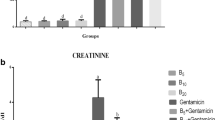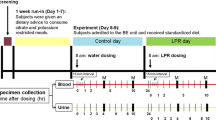Abstract
Boron plays roles in the metabolism of calcium, vitamin D, steroid hormones, healthy bone development, and maintenance of cell membranes. The biological effects of boron are dose-dependent but follow a U-shaped pattern, rendering it important to define the active range. The studies of Bahadoran et al. on rats and Naghii et al. on humans showed that low doses of boron (3 and 10 mg/day) prevented kidney stone formation. The aim of this study was to determine whether high doses of boron have an anti-urolithiatic or antioxidant effect on nephrolithiasis in an experimental rat model. The study was conducted on 50 adult male Wistar rats randomized to five groups. Nephrolithiasis was induced with water containing 0.75% ethylene glycol (EG) and 2% ammonium chloride (AC). This treatment was given to animals in all groups for 10 days, except the positive and negative controls. Simultaneously, groups 2, 3, and 4 were given boric acid via gavage at doses of 25, 50, and 100 mg/kg/day (equivalent to 4/8/16 mg boron respectively) as the source of boron. Animals in the negative and positive control groups were given 6 μL/g distilled water without boric acid. At day 10, intra-cardiac blood samples were drawn from all animals. The right and left kidneys were removed for biochemical and histopathological examinations, respectively. The groups were compared with respect to serum urea, creatinine, calcium, phosphorous, total antioxidant status (TAS), total oxidant status (TOS), serum paraoxonase (PON1) activity, tissue calcium and oxalate levels, and stone burden as determined by histopathological examination. Serum urea and creatinine levels were significantly higher (p < 0.001 and p < 0.05, respectively), while serum calcium and phosphorous levels were significantly lower (p < 0.001 and p < 0.001, respectively), in animals given EG/AC compared to negative controls. No significant differences were detected in serum calcium, phosphorous, urea, or creatinine levels between animals treated with boron and positive controls (p > 0.05). Serum PON1 activity was significantly lower in animals given EG/AC than in negative controls (p < 0.001), while no significant difference in serum PON1 level was detected between rats treated with boron and positive controls. No significant differences were detected in vitamin D, TAS, TOS, tissue calcium, or tissue oxalate levels among groups. No stone formation was detected on histopathological examination in negative controls. No significant differences were found in stone formation between rats treated with boron and positive controls. Based on this study, high doses of boron had no protective effect against nephrolithiasis and oxidative stress.



Similar content being viewed by others
References
Bushinsky DA, Coe FL, Moe OW (2008) Nephrolithiasis. In: Brenner BM (ed) The kidney, 8th edn. Saunders, Philadelphia (PA), pp 1299–1375
Khan SR (2004) Role of renal epithelial cells in the initiation of calcium oxalate stones. Nephron Exp Nephrol 98:55–60
Naghii MR, Jafari M, Mofid M, Eskandari E, Hedayati M, Khalagie K (2015) The efficacy of antioxidant therapy against oxidative stress and androgen rise in ethylene glycol induced nephrolithiasis in Wistar rats. Hum Exp Toxicol 34:744–754
Uluisik I, Karakaya HC, Koc A (2018) The importance of boron in biological systems. J Trace Elem Med Biol 45:156–162
Hunt CD (2012) Dietary boron: progress in establishing essential roles in human physiology. J Trace Elem Med Biol 26:157–160
Naghii MR, Mofid M, Asgari AR, Hedayati M, Daneshpour MS (2011) Comparative effects of daily and weekly boron supplementation on plasma steroid hormones and proinflammatory cytokines. J Trace Elem Med Biol 25:54–58
Naghii MR, Einollahi B, Rostami Z (2012) Preliminary evidence hints at a protective role for boron in urolithiasis. J Altern Complement Med 18:207–209
Miljkovic D, Miljkovic N, McCarty MF (2004) Up-regulatory impact of boron on vitamin D function: does it reflect inhibition of 24-hydroxylase? Med Hypotheses 63:1054–1056
Bahadoran H, Naghii MR, Mofid M, Asadi MH, Ahmadi K, Sarveazad A (2016) Protective effects of boron and vitamin E on ethylene glycol-induced renal crystal calcium deposition in rat. Endocr Regul 50:194–206
Naghii MR, Eskandari E, Mofid M, Jafari M, Asadi MH (2014) Antioxidant therapy prevents ethylene glycol-induced renal calcium oxalate crystal deposition in Wistar rats. Int Urol Nephrol 46:1231–1238
Smoum R, Rubinstein A, Dembitsky VM, Srebnik M (2012) Boron containing compounds as protease inhibitors. Chem Rev 112:4156–4220
Hu H, Zhang J, Lu Y, Zhang Z, Qin B, Gao H et al (2017) Association between circulating vitamin D level and urolithiasis: a systematic review and meta-analysis. Nutrients 18, 9
Erel O (2004) A novel automated method to measure total antioxidant response against potent free radical reactions. Clin Biochem 37:112–119
Erel O (2005) A new automated colorimetric method for measuring total oxidant status. Clin Biochem 38:1103–1111
Hodgkinson A, Williams A (1972) An improved colorimetric procedure for urine oxalate. Clin Chim Acta 36:127–132
Bilbault H, Haymann JP (2016) Experimental models of renal calcium stones in rodents. World J Nephrol 6(5):189–194
Poldelski V, Johnson A, Wright S, Rosa VD, Zager RA (2001) Ethylene glycol-mediated tubular injury: identification of critical metabolites and injury pathways. Am J Kidney Dis 38:339–348
Atakan IH, Kaplan M, Seren G, Aktoz T, Gül H, Inci O (2007) Serum, urinary and stone zinc, iron, magnesium and copper levels in idiopathic calcium oxalate stone patients. Int Urol Nephrol 39:351–356
Pomara C, Fiore C, D'Errico S, Riezzo I, Fineschi V (2008) Calcium oxalate crystals in acute ethylene glycol poisoning: a confocal laser scanning microscope study in a fatal case. Clin Toxicol (Phila) 46:322–324
Devirian TA, Volpe SL (2003) The physiological effects of dietary boron. Crit Rev Food Sci Nutr 43:219–231
Murray FJ (1995) A human health risk assessment of boron (boric acid and borax) in drinking water. Regul Toxicol Pharmacol 22:221–230
Li Y, McMartin KE (2009) Strain differences in urinary factors that promote calcium oxalate crystal formation in the kidneys of ethylene glycol-treated rats. Am J Physiol Renal Physiol 296:1080–1087
Nielsen FH (2000) The emergence of boron as nutritionally important throughout the life cycle. Nutrition 16:512–514
Kobylewski SE, Henderson KA, Yamada KE, Eckhert CD (2017) Activation of the EIF2α/ATF4 and ATF6 pathways in DU-145 cells by boric acid at the concentration reported in men at the US mean boron intake. Biol Trace Elem Res 176:278–293
Henderson KA, Kobylewski SE, Yamada KE, Eckhert CD (2015) Boric acid induces cytoplasmic stress granule formation, eIF2α phosphorylation, and ATF4 in prostate DU-145 cells. Biometals 28:133–141
Altuner Torun Y, Ertural U, Ergul AB, Karakukcu C, Akin MA (2017) Reduction in serum paraoxonase level in newborns with hyperbilirubinemia as a marker of oxidative stress. J Matern Fetal Neonatal Med 30:2297–2300
Hunt CD (1994) The biochemical effects of physiologic amounts of dietary boron in animal nutrition models. Environ Health Perspect 102:35–43
Acknowledgments
The English in this document has been checked by at least two professional editors, both native speakers of English. For a certificate, please see: http://www.textcheck.com/certificate/FnQiaG
Author information
Authors and Affiliations
Corresponding author
Rights and permissions
About this article
Cite this article
Ergul, A.B., Kara, M., Karakukcu, C. et al. High Doses of Boron Have No Protective Effect Against Nephrolithiasis or Oxidative Stress in a Rat Model. Biol Trace Elem Res 186, 218–225 (2018). https://doi.org/10.1007/s12011-018-1294-1
Received:
Accepted:
Published:
Issue Date:
DOI: https://doi.org/10.1007/s12011-018-1294-1




